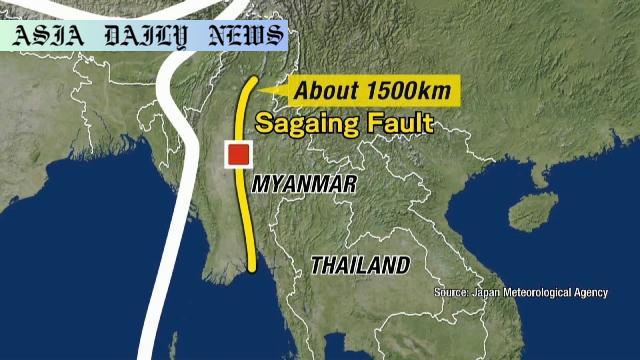Sagaing Fault: A detailed analysis reveals seismic activity, destructive force, and future risks along one of Earth’s longest faults.
Sagaing Fault moved during a 7.7 magnitude earthquake near Mandalay.
Professor Tsutsumi explains fault rupture intervals and historical patterns.
Professor Yagi highlights the quake’s unusually fast and destructive fault propagation.
Experts warn about future risks from unruptured fault sections.

Understanding the Sagaing Fault and Its Seismic Significance
The Sagaing Fault is one of the most significant active fault lines in the world, stretching approximately 1,500 kilometers in a north-south direction. Originating from the collision between the Indo-Australian plate and the Himalayas, this fault is a complex geological divide responsible for significant seismic activity over centuries. Professor Tsutsumi Hiroyuki from Doshisha University explains that the fault’s south-central segment triggered a massive earthquake with a preliminary magnitude of 7.7 near Mandalay, Myanmar.
Historical records indicate that magnitude-7-class earthquakes have repeatedly occurred along different sections of this fault since the 1800s, with intervals ranging from 100 to 200 years. The last major quake of similar intensity in the southern portion of the fault happened in 1839. This historical context underlines the episodic yet devastating nature of the Sagaing Fault’s geological activity. Professor Tsutsumi emphasizes caution, noting the potential for aftershocks and secondary quakes in the coming weeks or months, especially along unruptured sections of the fault.
The Unique Fault Propagation Dynamics of the 2023 Earthquake
University of Tsukuba’s Professor Yagi Yuji provides a detailed analysis of the fault rupture during the latest quake. By closely analyzing seismic wave patterns, Yagi identified how the rupture began at the epicenter and spread southward over 10 seconds before continuing both northward and southward for an additional 60 seconds. This phenomenon, where rupture propagation reaches or exceeds the velocity of ground-shaking seismic waves (S waves), is particularly noteworthy as it increases the quake’s destructive energy potential.
Yagi highlights that this rapid and irregular rupture dynamics directly contributed to the earthquake’s considerable destructive force. The significant energy released during such an event can amplify its impact over a broader area, and neighboring regions like Thailand likely experienced substantial damage due to their geographical position relative to the fault rupture direction. This emphasizes how even regions outside of immediate seismic zones can face serious consequences when fault dynamics are extreme.
Future Risks and Preparedness
Experts are highlighting unruptured portions of the Sagaing Fault as areas of concern. Over time, these sections accumulate strain that may eventually be released in future seismic events. The southern areas of the fault have not experienced major rupture in recent decades, raising the risk of future earthquakes with potentially catastrophic consequences.
Proactive measures and preparedness are therefore critical for communities near the fault line, as well as those situated further afield but in potential seismic wave propagation paths. Urban planning, emergency systems, and international cooperation need to be prioritized to mitigate the risks associated with these unpredictable natural phenomena. Awareness campaigns must also be implemented to educate residents on safety measures during and after quakes.
This in-depth analysis of the Sagaing Fault and the recent earthquake underscores the ever-present threat posed by these geological features. By better understanding their dynamics, nations in seismically active zones can work collaboratively toward enhanced prevention and response strategies.



Commentary
The Complexity of Seismic Faults and Human Understanding
Seismic faults like Myanmar’s Sagaing Fault pose significant challenges to both scientists and the communities living near them. The complexity of their behavior, as highlighted by the recent 7.7 magnitude earthquake, underscores how much more there is to learn about geology and seismic risks. Faults are not just theoretical lines on geological maps; they are dynamic and powerful forces of nature that remind humanity of the Earth’s abruptly destructive potential.
Professor Tsutsumi’s historical insights into the Sagaing Fault highlight the importance of long-term data collection in understanding earthquake patterns. His estimation of quakes occurring every 100 to 200 years is a sobering reminder of how cyclical nature can be, often in scales that exceed human memory or records. Equally fascinating is Professor Yagi’s analysis of the fault’s unusually fast propagation, which reveals the capability of some faults to unleash devastating energy in unexpected ways. It is through these dedicated scientists that societies can learn to coexist with seismic threats by preparing for what might come.
Mitigation and Improved Awareness are Key
What is striking about the Sagaing Fault is how the effects of a rupture are not limited to the immediate area. As Yagi discusses, the way seismic waves extend can impact neighboring countries such as Thailand, even causing significant destruction hundreds of kilometers away. This challenges outdated notions that only populations directly above a fault line need to prepare for danger.
Governments, researchers, and international bodies must coordinate to implement comprehensive risk mitigation strategies. Building codes, early warning systems, and public education initiatives must be enhanced in regions prone to such geological events. Disasters on this scale also often reveal how unprepared many areas are for such occurrences. It is essential to convert these tragedies into learning opportunities to reduce vulnerabilities in the future.
Hope in Scientific Advancement
At the heart of this analysis is a message of both caution and hope. While the unpredictable nature of seismic faults will always remain a challenge, advancements in technology and research continue to improve our understanding of these phenomena. With community participation and scientific collaboration, it is possible to reduce the devastating toll earthquakes can have on both life and infrastructure. This responsibility doesn’t just fall on scientists and governments; it belongs to all of us living on this dynamic and ever-changing planet.